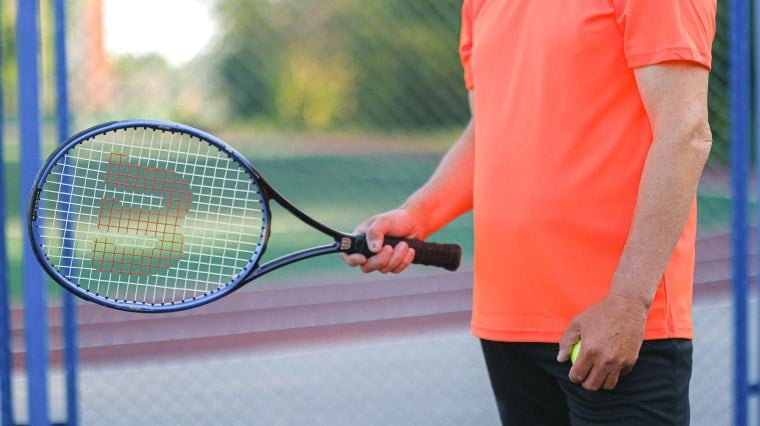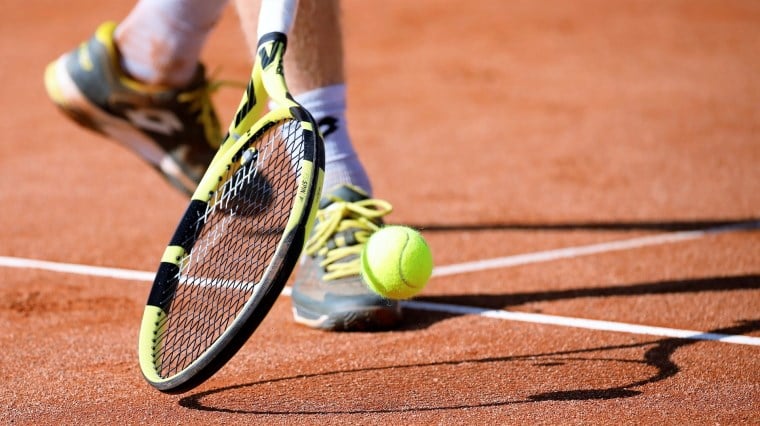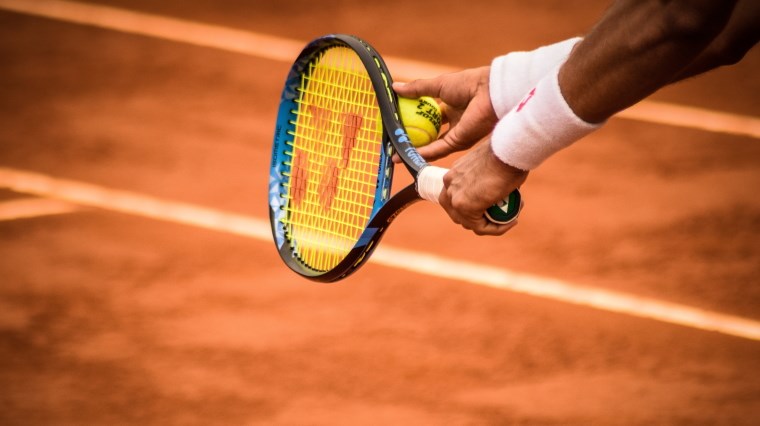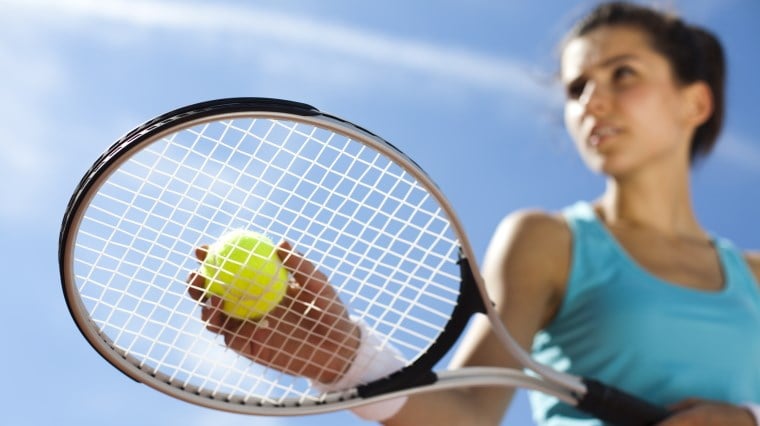A Beginner’s Guide To Tennis Racquet Specs

With the Australian Open just around the corner, you’ve probably been hit with tennis fever and are eager to take your tennis passion to the next level.
Whether you’re investing in your first tennis racquet or upgrading your court weapon to meet the demands of your improving skills, it’s important to choose a tennis racquet that has specs tailored to your playing style and ability level.
You’re guaranteed to come across the terms head size, weight, length, balance, string pattern and grip size in your search for the best tennis racquet for your skill level – but what do those specs on paper mean for your performance on the court?
Head Size
Head size is the term used to describe the size of the hitting surface area or 'face' within the tennis racquet frame. Measured in sq cm or sq in, it contains the intersecting strings (stringbed) that the tennis ball must contact during play.
Tennis racquet brands like Wilson divide head size down into three main categories, being Midsize (85 sq in to 97 sq in), Midplus (98 sq in to 104 sq in) and Oversize (105 sq in or more). Occasionally a brand may release a Super Oversize tennis racquet.
There is a direct relationship between the head size, head shape and the size of the sweet spot. The sweet spot is the point of impact at the centre of the head that is the most responsive, accurate and vibration-reducing on contact.
Oversize (105 sq in or more)
An oversize racquet naturally has an enlarged sweet spot, meaning they’re more forgiving on off-centre shots. With more room for error, they allow you to focus on sharpening stroke technique and timing. Due to their longer strings, an oversize tennis racquet may also increase the snapback or ‘trampoline effect’ on the ball as it sinks into then explosively ‘springs’ off the stringbed - making it easier for players to generate power.
Midplus (98 sq in to 104 sq in)
Midplus heads provide of blend of control and power teamed with a moderate sized sweet spot. They offer less power than an oversized racquet but more control, and more control than a midsize racquet but less power.
Midsize (85 sq in to 97 sq in)
Midsize racquets are refined for control with a smaller sweet spot. They heavily rely on the skill of the player to pin-point shots consistently, with minimal room for error.
Weight

There is a wide spectrum on offer when it comes to the weight of tennis racquets. According to Wilson, weight can be divided into three categories being lightweight (255 – 275g / 9 - 9.7oz), medium or mid weight (275 – 310g / 9.8 -11oz) and heavy weight (310g / 11oz or more).
The weight of your tennis racquet can greatly influence your playing experience. When assessing the weight, it’s important to consider what you want to get out of your tennis racquet. Generally, the lighter the racquet weight, the greater the manoeuvrability and the heavier the racquet weight, the more power you’re able to get out of your tennis racquet if you have the skill to do so.
Lightweight (255g - 275g)
Lightweight tennis racquets allow for improved mobility and speed, with the potential trade-off being reduced power. However, keep in mind that power can come from other characteristics of the racquet besides the overall weight (e.g. a lightweight racquet with an oversize head may provide the best of both worlds for beginners).
Mid weight (275g - 310g)
Mid weight tennis racquets provide a blend of power and control – making them a popular choice for intermediate players seeking an all-rounder tennis racquet.
Heavy weight (310g or more)
Heavy weight tennis racquets are ideal for strong players seeking stability and control to work in harmony with the explosive power they are personally capable of generating at their advanced skill level. In the right hands, more mass translates to more power.
Length
27in (68.58cm) is the standard length for full-sized tennis racquets for adults. Some tennis racquets may have a longer length for extended reach and leverage – generally measuring in at 27.5in (69.85cm) and up to 29in (73.66cm).
A longer tennis racquet generally is lighter – ensuring it doesn’t move cumbersomely on the court and may increase the potential for power.
Junior tennis racquets come in multiple lengths to suit the age and/or height of the child – from 19in (48.26cm) to 26in (66.04cm). These shorter lengths are easier to manoeuvre for little wrists as they sharpen their skills.
Balance

The balance point or ‘centre of mass’ is the point of the tennis racquet where the weight is evenly balanced on either side between handle and head. The balance point dictates where the mass is distributed throughout the length of the tennis racquet frame, influencing your level of control and power.
If you were to balance your tennis racquet on a balance bar or dowel at the balance point, neither the head or handle end would touch the ground. Imagine a see-saw balanced with the same weight applied to both ends of the beam, yet unlike a see-saw pivot point, the balance point of a tennis racquet isn’t necessarily centred between both ends.
The balance point is measured in mm or inches from the end of the handle or butt cap. When manufacturers refer to the balance in terms of head heavy (HH) or head light (HL) points, each ‘point’ represents a measurement of 1/8in (0.125in / 3.175mm).
Generally it’s recommended that beginner players have a balance point no more than 5 pts (5/8in) of either a head light (HL) or head heavy (HH) balance.
Even Balance
On a standard 27in length tennis racquet, 343mm (13.5in) is considered a neutral balance point or even balance and may also be written as 0 pts HL. This means the balance point is roughly centred between the topmost point of the head and the base of the handle (halfway up the racquet length) and weight is equally distributed. Keep in mind that the weight of the grip, butt cap and strings may also effect the balance point.
For players eager to continuously improve form, an even balance tennis racquet can be a beneficial partnership – whether as a transitional racquet before taking on a more advanced head light tennis racquet or as the go-to balance throughout their tennis journey as their skills advance.
They offer more control and less power than a head heavy balance, but more power and less control than a head light balance. With the ‘in-between’ attributes – being medium control and medium power - they don’t provide any specific edge in either direction but are valuable as an all-rounder.
Some players view them as the "no man’s land" of tennis racquets - without having the level of power that makes players gravitate towards the head heavy racquets, and without the level of control that makes players gravitate towards head light racquets. However, other players believe they offer the best of both worlds - heavy enough at the head for accessible power, and heavy enough at the handle for control, as well as shock-dampening to prevent arm-fatigue and create a more solid feel.
Head Heavy
A standard 27in head heavy racquet has a high balance point (more than 343mm / 13.5in) – over halfway up the racquet length with the weight distributed closer to the head. With more mass behind the ball, this allows you to more easily generate power to hit the ball deep with the increased momentum. However, with the centre of gravity further away from your body this does compromise on control.
Tennis racquets with a head heavy balance can be difficult to manoeuvre and may increase injury risk with higher torque resulting in stress to the shoulder, elbow and wrist. With less weight distributed in the handle, more shock is transferred to your arm on contact. To help counteract the potential problems with a head heavy racquets, tennis racquets that fall into this range are generally a lighter weight overall – balancing out the top-heavy design with improved manoeuvrability.
A head heavy balance in a lighter weight racquet ensures they have the additional power needed. Slower-swinging players and recreational baseliners may prefer these top-heavy racquets for their power, to increase the pace and clear the net more consistently and effortlessly when matched with a more methodical playing style.
Head Light
A head light balance on a standard 27in racquet has a low balance point (lower than 343mm / 13.5in), less than halfway up the racquet length with weight distributed closer to the handle. This improves control for players with proper technique and that are more capable of generating their own power and spin.
They’re ideal for the fast-paced nature of the modern game, in the hands of quick yet short-swinging players, and players that enjoy dominating from the net and mastering volleys.
Tennis racquets with a head light balance are generally heavier overall and have improved shock-absorption and vibration-dampening with a heavier handle. They are the preference of many intermediate to elite players, and some coaches may advise to get them in a beginner’s hand from the get-go to encourage proper technique.
String Pattern

String pattern refers to the grid of strings that intersect vertically and horizontally within the tennis racquet head. On the specs list of a tennis racquet, the value referring to string pattern firstly shows the number of main strings that run vertically and then cross strings that run horizontally (e.g. a tennis racquet with a string pattern of 16x18 or 16/18 has 16 main strings and 18 cross strings).
The space between strings (either open with fewer strings and larger spacing like a 16/19 string pattern, or dense with more strings and tightly packed spacing like an 18/20 string pattern) influences how the ball interacts with the stringbed.
Be aware the head size can also affect the response of the stringbed during play. It’s important to consider how the different specs of your tennis racquet compliment or offset one another to create desired performance – a particular string pattern in one tennis racquet, may feel entirely different in another.
We’ll discuss the most common string patterns, being 16/19 and 18/20 as well as a few others you may encounter.
18/20
This dense string pattern increases control, consistency and creates a crisper sensation on impact with a shorter dwell time (the amount of time the ball is in contact with the stringbed) compared to open string patterns. Control is provided by more strings being in play and in contact with the ball on impact – allowing you to direct the ball more confidently. Tennis racquets with this string pattern are a suitable option for flat-hitting players.
The trade-off is a reduced capacity for ball-pocketing, making it more difficult to whip up spin compared to an open string pattern. Being a dense string pattern, it relies on your ability to supply your own power to be effective. If you’re prone to breaking strings frequently, it’s worth keeping in mind that this string pattern generally increases the longevity of the strings.
16/20
A middle ground between the 18/20 and 16/19 string pattern, the 16/20 string pattern features strings that are more tightly packed at the sweet spot and more spaced out towards the edges of the frame – being strategically denser or more open in key zones. It provides a worthy blend between the characteristics that dominate in both these string patterns.
With less main strings than the 18/20, it offers increased snapback or ‘trampoline effect’ off the stringbed, while having the same number of cross strings ensures stability, control and a solid feel.
16/19
The 16/19 string pattern is what we most frequently see on the market. Compared to the 18/20, this open string pattern shifts the power and spin potential up a gear and is known for its ability to generate topspin more easily.
Keeping up with the demands of the fast-paced and modern game, the increased string movement provides better ‘bite’ on the ball as it sinks into the stringbed and delivers more satisfying snapback or rebound – making it easier to hit deep into the court. Be aware that this string pattern isn’t as durable as the dense 18/20 string pattern – so you may be replacing your strings more often.
16/18
This open string pattern increases the potential of the tennis racquet to produce power and spin. Increased space between the strings translates to greater elasticity of the stringbed for longer dwell time. This ensures a more explosive snapback effect and requires less from you as the player in regard to producing your own power.
Grip Size

Once you’ve decided on a tennis racquet, you’re also going to need to select a grip size. Grip size refers to the circumference around the racquet’s handle.
If your palm and fingers touch when holding the racquet grip, the grip size is too small - there should be an index finger’s width between your fingers and palm. To test, insert your index finger of the opposite hand between the thumb and fingers of the gripping hand when it’s in a forehand grip. The grip is too large if there is excess space around the index finger.
Ideally, demo the tennis racquet first to test whether a grip size is suitable for you by swinging the racquet through the air a couple of times to get an impression of the comfort and feel.
US grip sizes are measured in inches, from 4 1/8 to 4 5/8in. UK grip sizes are listed as 1 – 5 as per the conversion chart below.
1 – 4 1/8: Extra small. Suitable for children playing with a full-size tennis racquet.
2 – 4 1/4: Small. Generally suitable for older children and small-handed women.
3 – 4 3/8: Medium. Generally suitable for women and small-handed men.
4 – 4 1/2: Large. Generally suitable for men.
5 – 4 5/8: Extra large. Generally suitable for large-handed men.
Stuck between sizes? In this case generally it’s best to opt for a smaller size as overgrips allow you to customise the fit, thickening the grip whereas a larger grip size can’t be reduced.
Modern players may gravitate towards a smaller grip sizes – allowing spin to be generated more easily as you can whip the tennis racquet more freely with your wrist.
Now that you have improved your understanding of tennis racquet specs, we recommend reading How To Choose The Best Tennis Racquet For Your Skill Level that reveals which tennis racquet characteristics play well in the hands of beginner, intermediate and advanced players.
For more practical tennis content read What You Need To Know Before Buying Tennis Strings.
